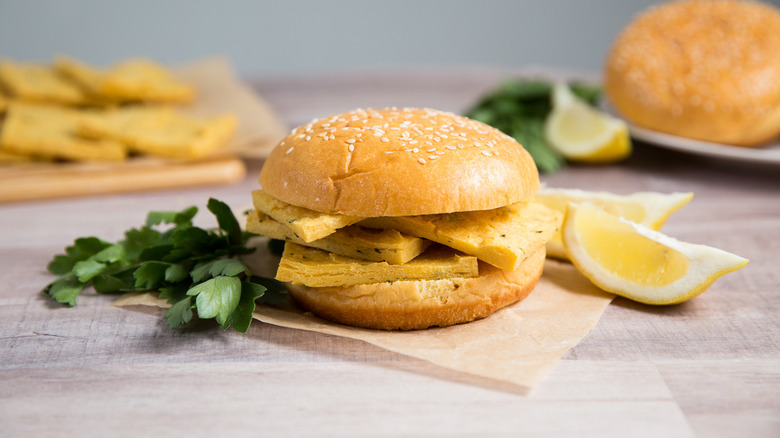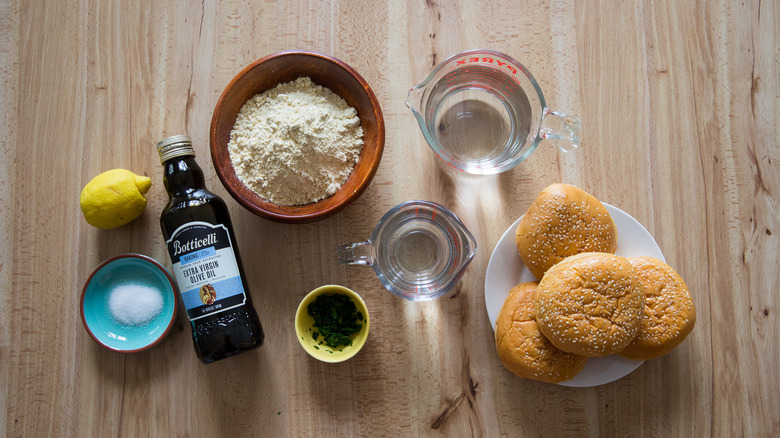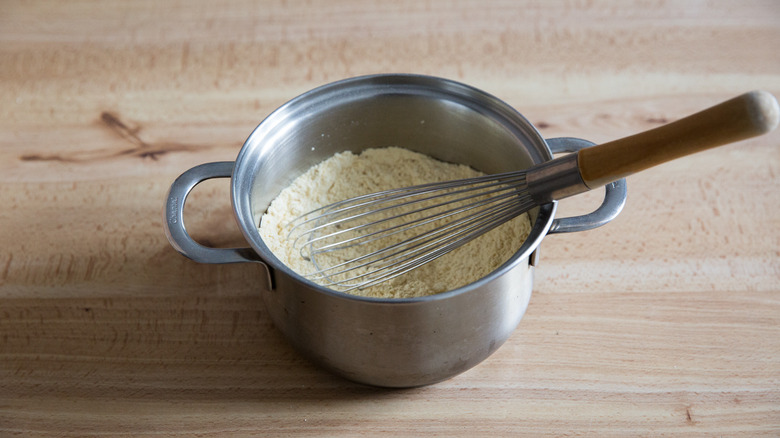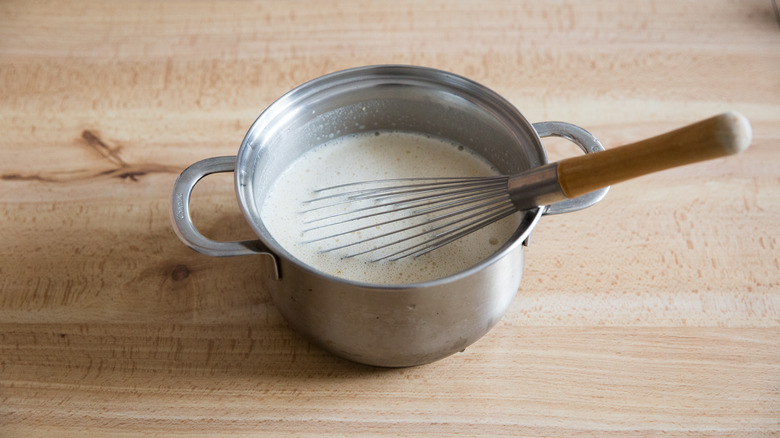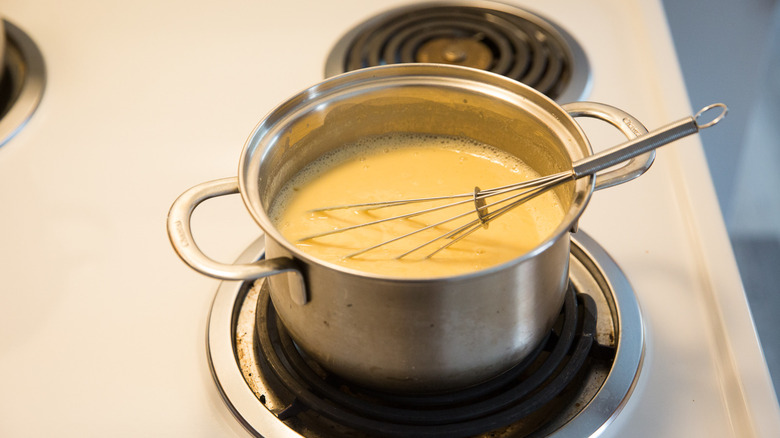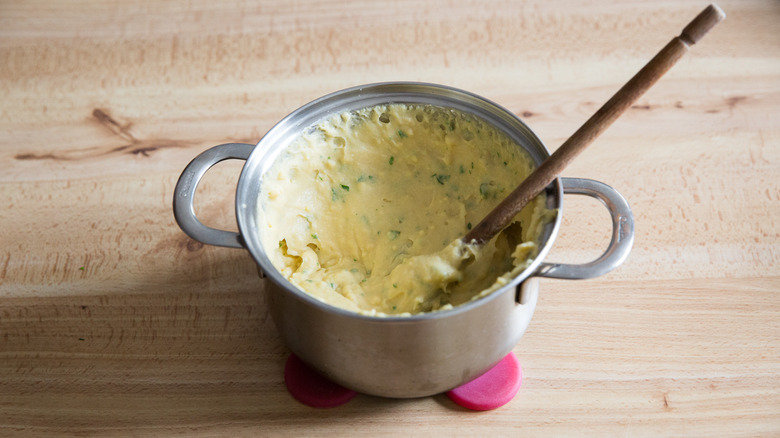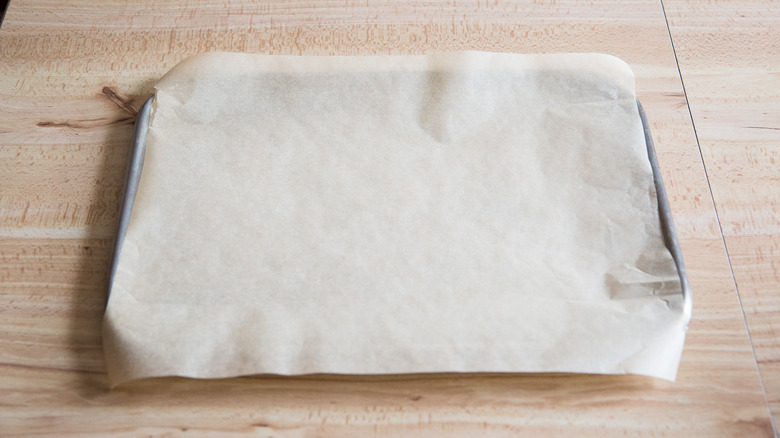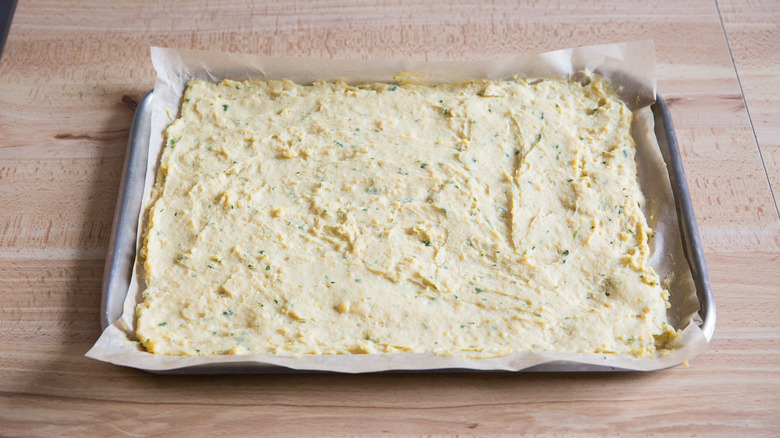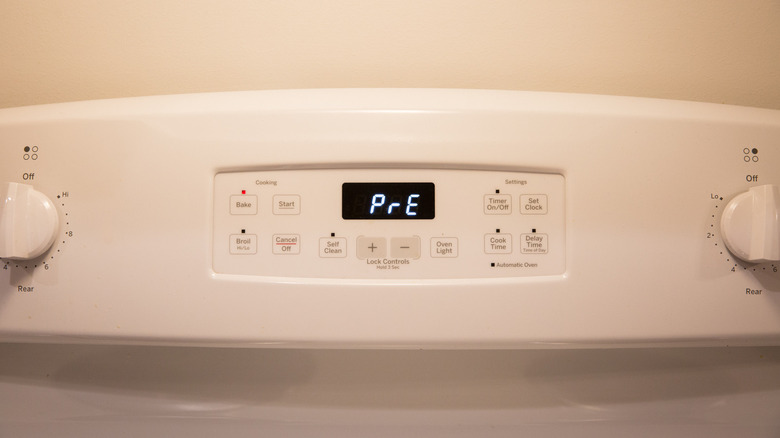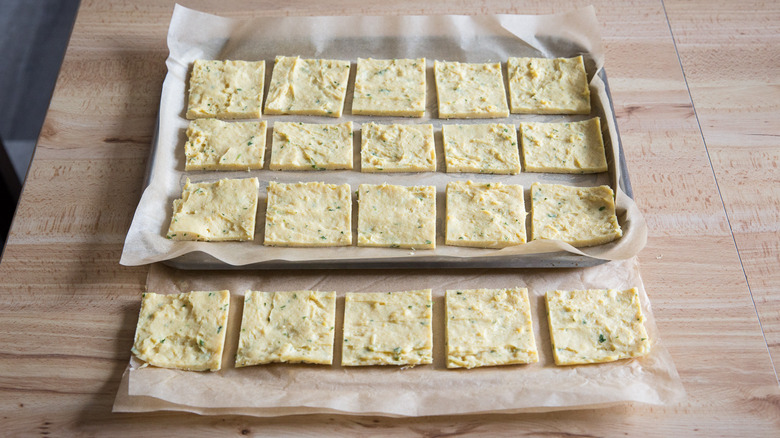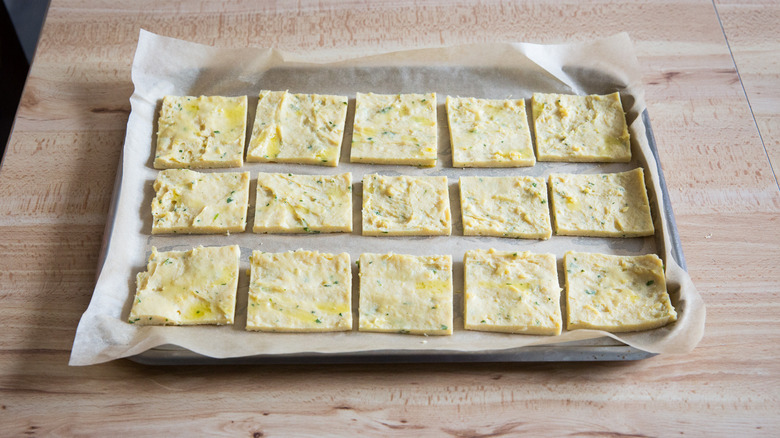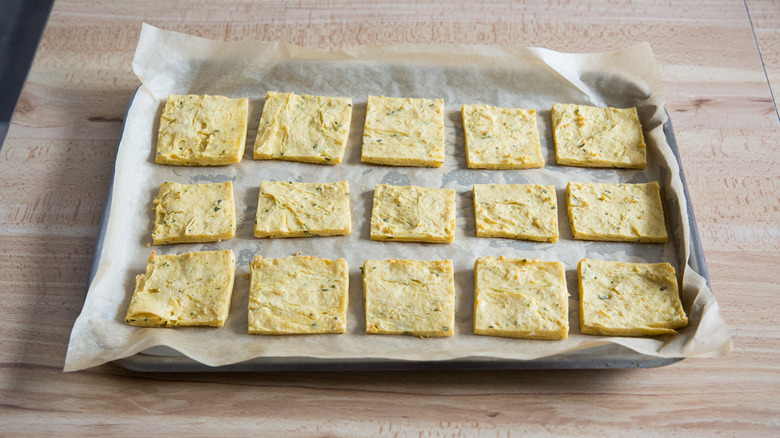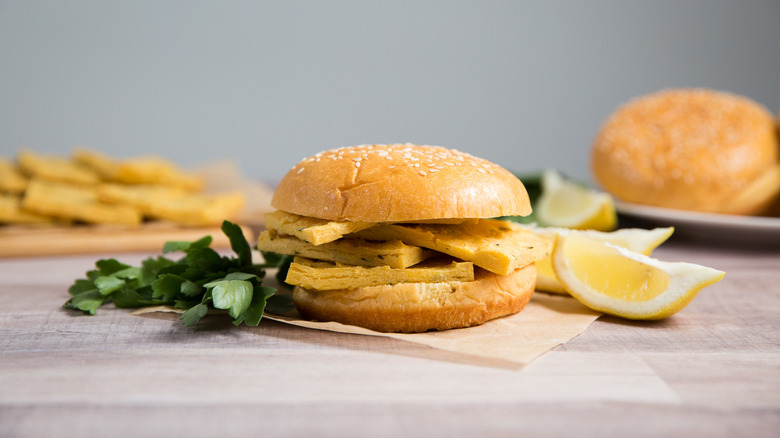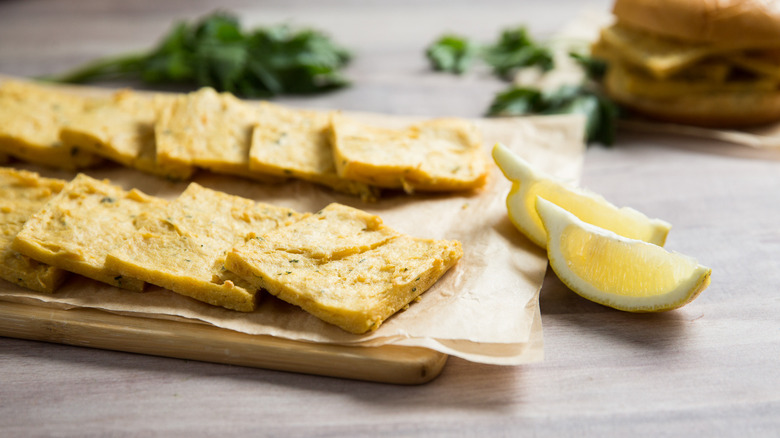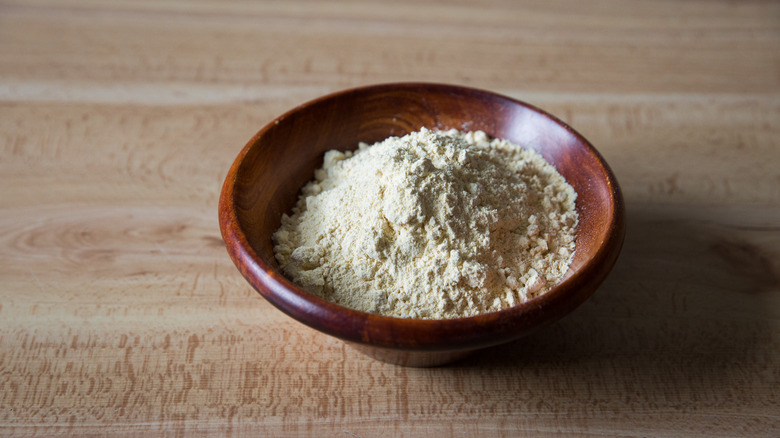Baked Panelle Sandwich Recipe
Panelle are a popular street food in Sicily. These fried chickpea flour fritters are served on special sesame seed rolls called vastedda and can be found in street food stalls and fried food shops around the region, especially in the capital city of Palermo. Only a few simple ingredients are needed to make them. The batter is made from chickpea flour, water, salt, and sometimes parsley. Panelle can be served on their own drizzled with lemon juice, but if you buy them on the street, they'll probably be served on a roll, sometimes with potato croquettes in the sandwich, too. Unlike farinata, a similar flat chickpea flour dish originating in the city of Genoa in the Northern Italian region of Liguria, panelle are also good served at room temperature (leftover farinata tends to get too dense and dry).
Recipe developer Michelle Bottalico has created a baked panelle sandwich recipe that allows you to bring this delicious Italian street food into your home. Don't be intimated by the two-hour recipe, because half of that is resting time. The process is similar to polenta — you'll cook and stir the chickpea flour mixture on low before spreading it out to cool and firm up. Then, you can cut it into shapes. We chose squares, but Italians cut them into rectangles, triangles, and rhombuses, too. We think you won't even mind the 10 minutes of continuous stirring once you get your first taste of these hot, crispy, creamy, and simply irresistible panelle.
Gather your panelle sandwich ingredients
First, you will need chickpea flour. The kind that's good for this recipe is also called garbanzo bean flour. Avoid the varieties called besan or gram flour because they're made with a different kind of chickpea. The other batter ingredients are water, salt, and parsley. You'll use olive oil for greasing the baking sheet and for drizzling on the panelle before they bake. Have lemon juice and soft sesame seed rolls on hand for serving the panelle sandwiches.
Step 1: Whisk the flour and salt
Place the chickpea flour and salt in a medium saucepan and whisk well.
Step 2: Whisk in the water
Slowly pour the water in a little at a time, whisking continuously. Don't pour all of the water in at once or it will be hard to get the clumps out.
Step 3: Cook the chickpea flour mixture
Heat the pan on medium, stirring continuously so that the flour doesn't stick to the bottom. Once the mixture comes to a boil, lower it to a simmer and stir continuously for about 10 minutes, until thickened. It should be compact and fall off the spoon extremely slowly.
Step: Stir in the parsley
Remove the pan from the heat and stir in the parsley.
Step 5: Line the baking sheet
Line a large baking sheet with parchment paper.
Step 6: Spread the mixture onto the baking sheet
Pour the mixture onto the baking sheet and, using a knife or a spatula, spread it into an even layer about ¼ inch high. Adjust the edges to make them straight so that no scraps are wasted later. Set aside to cool completely, about 1 hour.
Step 7: Preheat the oven
Preheat the oven to 400 F.
Step 8: Cut out the panelle
Cut even shapes (rectangles, squares, or triangles) out of the cooled chickpea mixture with a knife or cookie cutter and place them on a parchment paper–lined baking sheet. Use two sheets, if necessary.
Step 9: Drizzle oil on the panelle
Drizzle a little olive oil on top of the panelle.
Step 10: Bake the panelle
Bake for 30–35 minutes, until the underside and edges are lightly browned.
Step 11: Serve the baked panelle sandwiches
Squeeze a little lemon juice on the panelle before serving hot or at room temperature on soft sesame seed buns.
Baked Panelle Sandwich Recipe
Panelle are a Sicilian street food favorite, and this simple recipe bakes the often-fried squares of chickpea flour for a lighter, just as delicious sandwich.
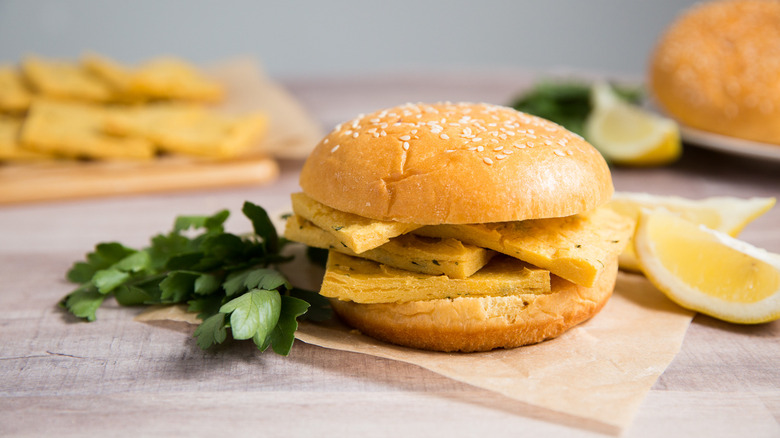
Ingredients
- 1 ¾ cups chickpea flour
- 1 teaspoon salt
- 3 cups + 3 tablespoons water
- 1 tablespoon minced parsley
- Olive oil, for greasing/drizzling
- 1 lemon
- 4 soft sesame seed rolls
Directions
- Place the chickpea flour and salt in a medium saucepan and whisk well.
- Slowly pour the water in a little at a time, whisking continuously. Don't pour all of the water in at once or it will be hard to get the clumps out.
- Heat the pan on medium, stirring continuously so that the flour doesn't stick to the bottom. Once the mixture comes to a boil, lower it to a simmer and stir continuously for about 10 minutes, until thickened. It should be compact and fall off the spoon extremely slowly.
- Remove the pan from the heat and stir in the parsley.
- Line a large baking sheet with parchment paper.
- Pour the mixture onto the baking sheet and, using a knife or a spatula, spread it into an even layer about ¼ inch high. Adjust the edges to make them straight so that no scraps are wasted later. Set aside to cool completely, about 1 hour.
- Preheat the oven to 400 F.
- Cut even shapes (rectangles, squares, or triangles) out of the cooled chickpea mixture with a knife or cookie cutter and place them on a parchment paper–lined baking sheet. Use two sheets, if necessary.
- Drizzle a little olive oil on top of the panelle.
- Bake for 30–35 minutes, until the underside and edges are lightly browned.
- Squeeze a little lemon juice on the panelle before serving hot or at room temperature on soft sesame seed buns.
Nutrition
| Calories per Serving | 302 |
| Total Fat | 8.3 g |
| Saturated Fat | 1.2 g |
| Trans Fat | 0.0 g |
| Cholesterol | 0.0 mg |
| Total Carbohydrates | 44.4 g |
| Dietary Fiber | 6.2 g |
| Total Sugars | 5.0 g |
| Sodium | 680.6 mg |
| Protein | 12.5 g |
How do I fry panelle?
Panelle are traditionally fried, and this is how you will find them on the street in Sicily. Anyone avoiding deep-fried foods has the option to bake them when making them at home, like we do in this recipe. However, you can easily fry them instead.
Skip the steps for preheating the oven and placing the cut-out panelle on a baking sheet. Then, heat a generous amount of vegetable oil in a large pan. You'll need enough to submerge the panelle, but they're only about ¼ inch high. When the oil is hot, place a few panelle in the oil. You'll need to cook them in batches so that they have enough room in the pan to cook without touching. Let them cook for 2–3 minutes, until golden. There's no need to turn them. When you fry them, they will puff up a little and develop a crispy exterior while maintaining a soft interior. When the time is up, drain the panelle with a slotted spoon and place them on absorbent paper towels. If frying is your preference, you'll find panelle cooked this way to be simply delicious.
What other dishes can I make with chickpea flour?
Chickpea flour is a common ingredients in cuisines such as Indian, Italian, and French, and it's a great, high-protein ingredient to have on hand for vegetarian cooking. This recipe, which comes from Italy, is made from ground beige-colored chickpeas also known as garbanzo beans. You may see another kind of chickpea flour used in Indian cuisine. It's called besan or gram flour, and it's made from brown desi chickpeas. Be careful about substituting that into this recipe because it requires a different amount of water and has a slightly different flavor.
Chickpea flour provides a good texture for gluten-free baking, but it has plenty of other uses. The Italian dish farinata is made from a batter of chickpea flour, water, olive oil, and salt, which is poured in a thin layer into special large copper pans and baked in a very hot oven until crispy, flaky, and irresistible. It sometimes includes rosemary in the batter and is served with ground black pepper. The French street food socca is very similar to farinata, as it also originated the Italian region of Liguria.
Chickpea flour also makes an excellent vegan omelet or quiche. Mix the flour with water without making it too thin. Add olive oil, salt, and sauteed vegetables, such as onion, zucchini, or bell pepper. Cook thin omelets one at a time in a frying pan, or pour the batter into a pie crust and bake a delicious flavorful quiche.
